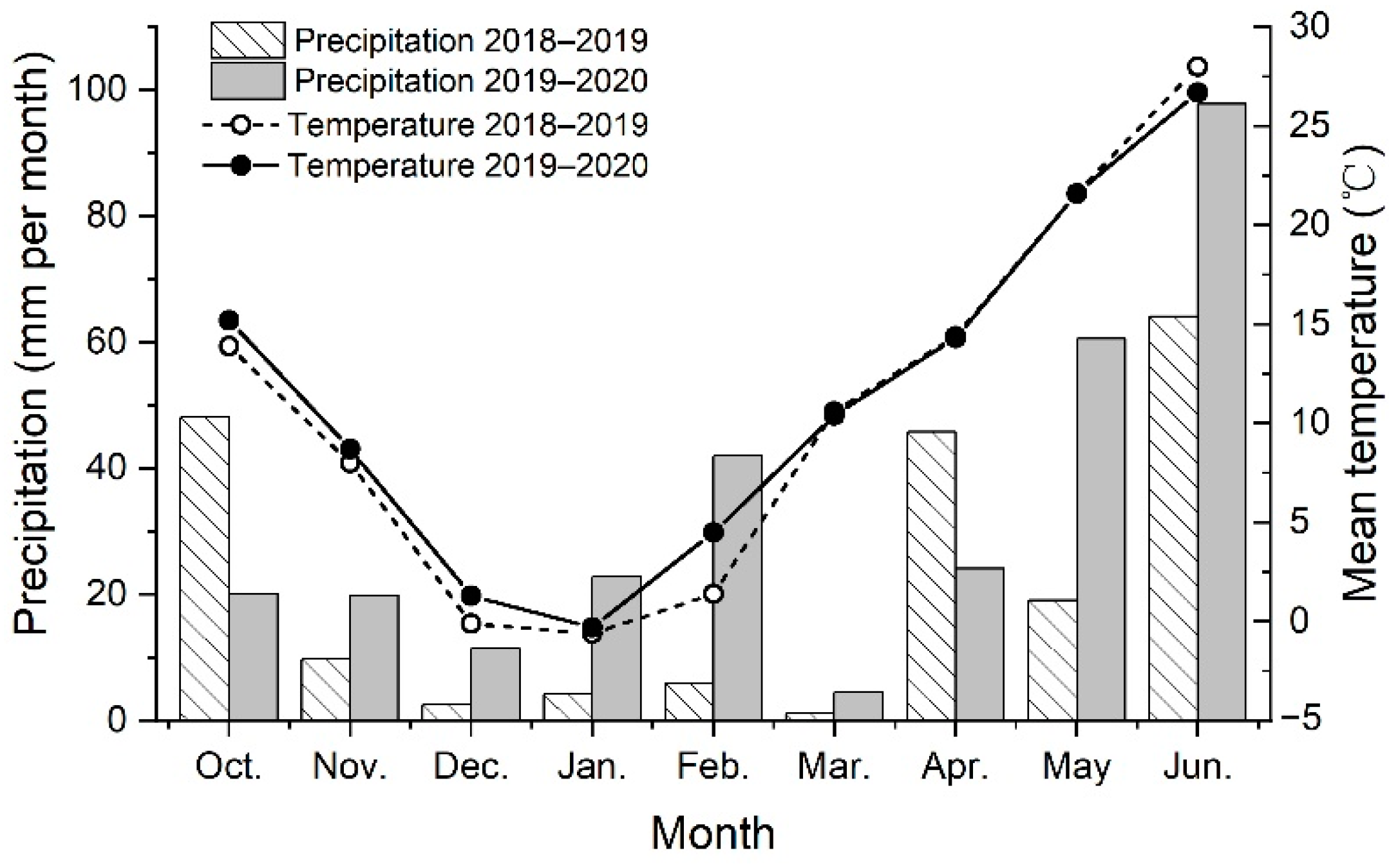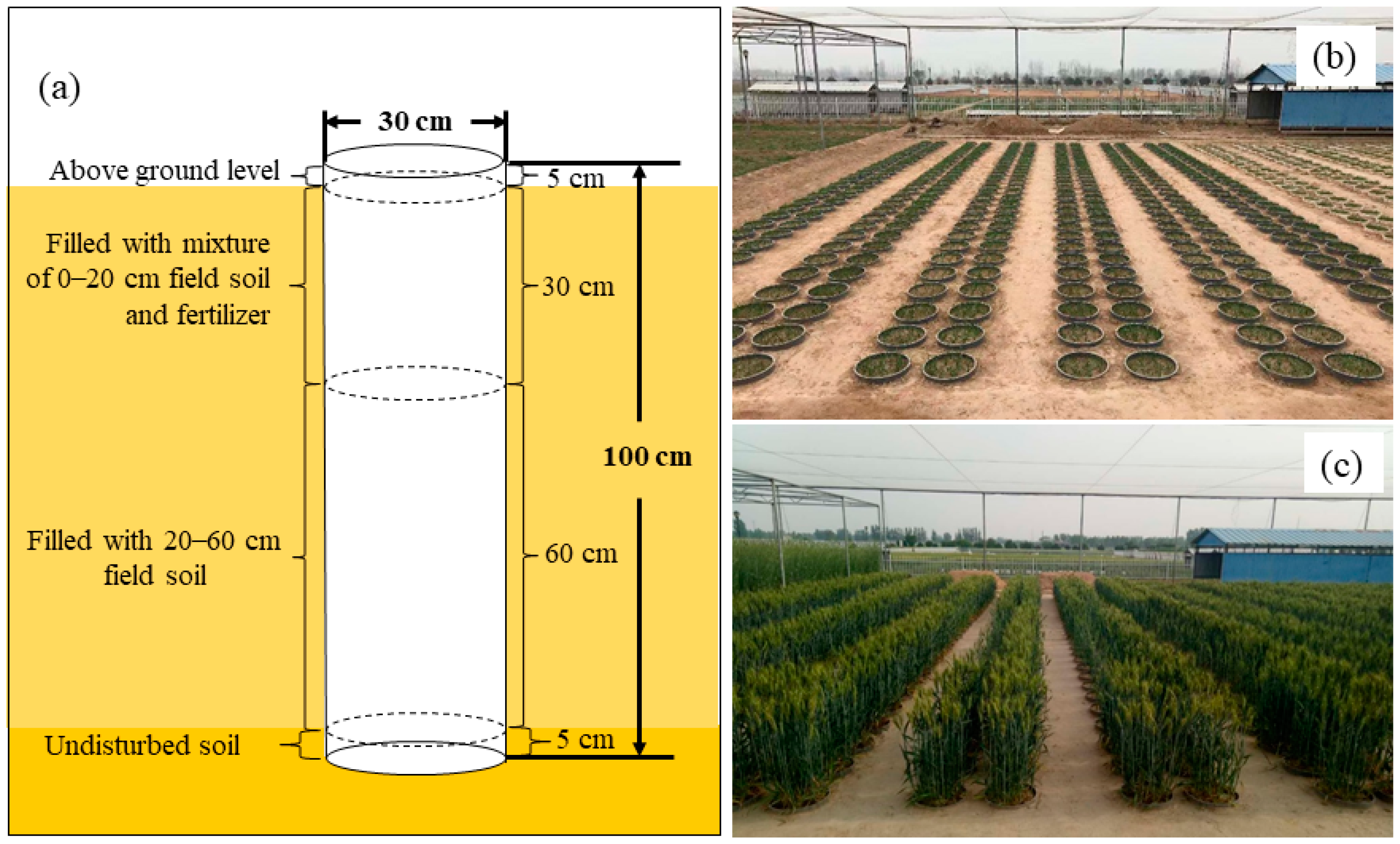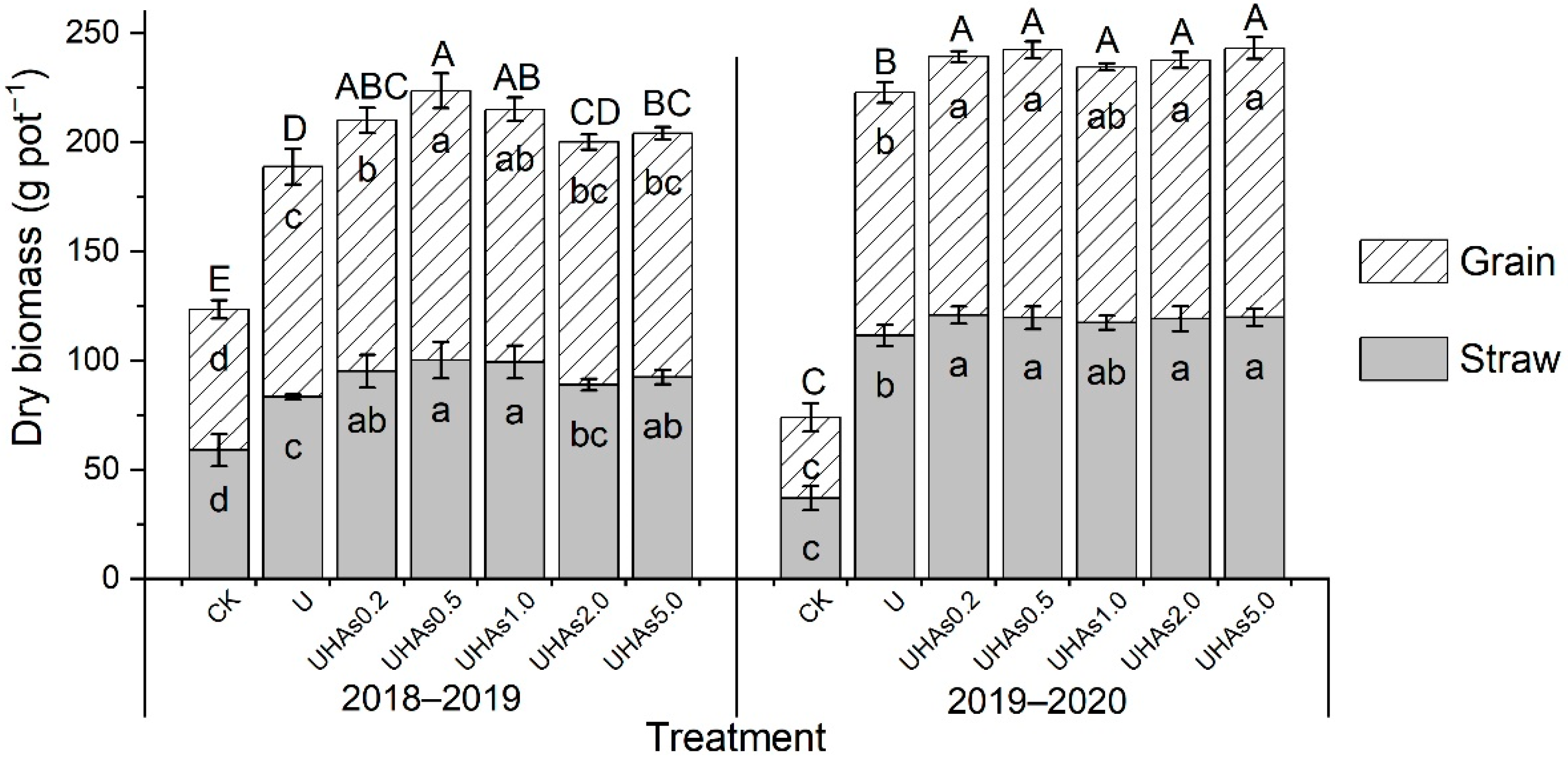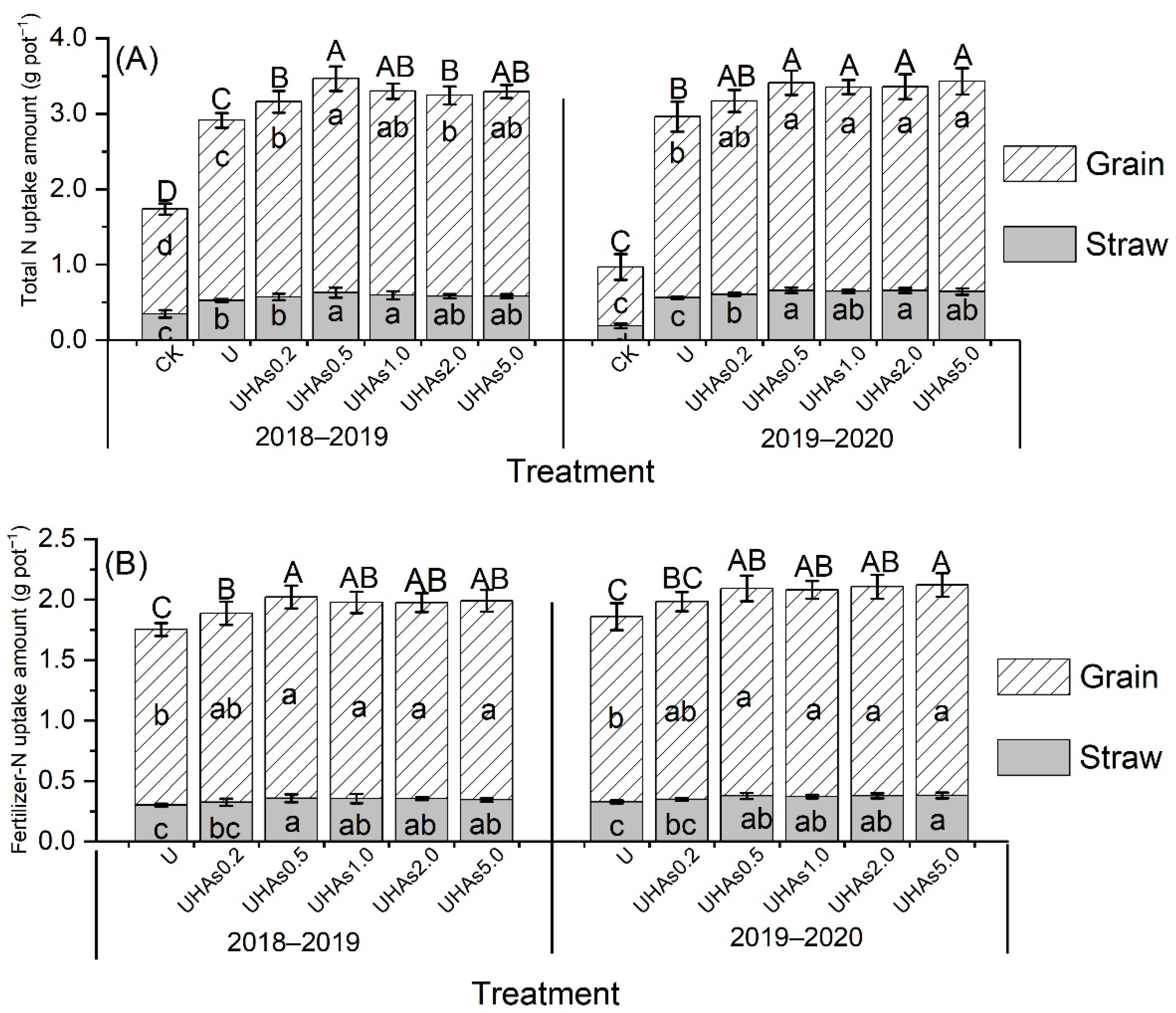Humic Acids Incorporated into Urea at Different Proportions Increased Winter Wheat Yield and Optimized Fertilizer-Nitrogen Fate
Abstract
:1. Introduction
2. Materials and Methods
2.1. Experimental Site
2.2. Experimental Materials
2.3. Experimental Design and Field Management
2.4. Sampling and Analysis
2.5. Statistical Calculation and Analysis
3. Results
3.1. Wheat Yield and Yield Components
3.2. N Uptake in Mature Winter Wheat
3.3. Fertilizer-N Distribution in Soil at Wheat Maturity
3.4. Fertilizer-N Fate in the Plant-Soil System at Wheat Maturity
4. Discussion
4.1. Higher Wheat Yields under UHAs Treatment Correlated with Increased Spike Number
4.2. Higher N Uptake and NUE under UHAs Applications with Lower Loss Rates
4.3. Use of 0.5% HAs in UHAs Optimally Enhances Yield and Fertilizer-N Fate of Winter Wheat
5. Conclusions
Supplementary Materials
Author Contributions
Funding
Data Availability Statement
Acknowledgments
Conflicts of Interest
References
- Makino, A. Photosynthesis, Grain yield, and nitrogen utilization in rice and wheat. Plant Physiol. 2010, 155, 125–129. [Google Scholar] [CrossRef] [PubMed] [Green Version]
- Liu, B.; Zhao, X.; Li, S.; Zhang, X.; Virk, A.L.; Qi, J.; Kan, Z.; Wang, X.; Ma, S.; Zhang, H. Meta-analysis of management-induced changes in nitrogen use efficiency of winter wheat in the North China Plain. J. Clean. Prod. 2020, 251, 119632. [Google Scholar] [CrossRef]
- Zhang, X.; Davidson, E.A.; Mauzerall, D.L.; Searchinger, T.D.; Dumas, P.; Shen, Y. Managing nitrogen for sustainable development. Nature 2015, 528, 51–59. [Google Scholar] [CrossRef] [PubMed] [Green Version]
- Ju, X.; Xing, G.; Chen, X.; Zhang, S.; Zhang, L.; Liu, X.; Cui, Z.; Yin, B.; Christie, P.; Zhu, Z. Reducing environmental risk by improving N management in intensive Chinese agricultural systems. Proc. Natl. Acad. Sci. USA 2009, 106, 3041–3046. [Google Scholar] [CrossRef] [PubMed] [Green Version]
- Zhao, B. Developing value-added urea technology to promote technology upgrade of urea. Phosphate Compd. Fertil. 2013, 28, 6–7. [Google Scholar]
- Martinez, C.; Clarke, D.; Dang, Y.P.; Janke, C.; Bell, M.J. Integrated field assessment of nitrogen release dynamics and crop recovery of band-applied controlled-release fertilisers. Plant Soil 2021, 466, 257–273. [Google Scholar] [CrossRef]
- Deng, F.; Wang, L.; Ren, W.-J.; Mei, X.-F. Enhancing nitrogen utilization and soil nitrogen balance in paddy fields by optimizing nitrogen management and using polyaspartic acid urea. Field Crops Res. 2014, 169, 30–38. [Google Scholar] [CrossRef]
- Zhao, B.; Yuan, L.; Li, Y.; Zhang, S. Overview of Value-Added Fertilizer; China Agricultural Sciences and Technology Press: Beijing, China, 2020. [Google Scholar]
- Calvo, P.; Nelson, L.; Kloepper, J.W. Agricultural uses of plant biostimulants. Plant Soil 2014, 383, 3–41. [Google Scholar] [CrossRef] [Green Version]
- Vujinovic, T.; Zanin, L.; Venuti, S.; Contin, M.; Ceccon, P.; Tomasi, N.; Pinton, R.; Cesco, S.; De Nobili, M. Biostimulant action of dissolved humic substances from a conventionally and an organically managed soil on nitrate acquisition in maize plants. Front. Plant Sci. 2019, 10, 1652. [Google Scholar] [CrossRef]
- Sądej, W.; Żołnowski, A.C. Comparison of the effect of various long-term fertilization systems on the content and fractional composition of humic compounds in Lessive soil. Plant Soil Environ. 2019, 65, 172–180. [Google Scholar] [CrossRef] [Green Version]
- Saha, B.K.; Rose, M.T.; Wong, V.; Cavagnaro, T.R.; Patti, A.F. Hybrid brown coal-urea fertiliser reduces nitrogen loss compared to urea alone. Sci. Total Environ. 2017, 601–602, 1496–1504. [Google Scholar] [CrossRef] [PubMed]
- Saha, B.K.; Rose, M.T.; Wong, V.N.L.; Cavagnaro, T.R.; Patti, A.F. A slow release brown coal-urea fertiliser reduced gaseous N loss from soil and increased silver beet yield and N uptake. Sci. Total Environ. 2019, 649, 793–800. [Google Scholar] [CrossRef] [PubMed]
- Shen, Y.; Lin, H.; Gao, W.; Li, M. The effects of humic acid urea and polyaspartic acid urea on reducing nitrogen loss compared with urea. J. Sci. Food Agric. 2020, 100, 4425–4432. [Google Scholar] [CrossRef] [PubMed]
- Li, Y.; Tan, W.; Koopal, L.K.; Wang, M.; Liu, F.; Norde, W. Influence of soil humic and fulvic acid on the activity and stability of lysozyme and urease. Environ. Sci. Technol. 2013, 47, 5050–5056. [Google Scholar] [CrossRef]
- Dong, L.; Córdova-Kreylos, A.L.; Yang, J.; Yuan, H.; Scow, K.M. Humic acids buffer the effects of urea on soil ammonia oxidizers and potential nitrification. Soil Biol. Biochem. 2009, 41, 1612–1621. [Google Scholar] [CrossRef] [Green Version]
- Yuan, L.; Zhao, B.; Lin, Z.; Wen, Y.; Li, Y. Effects of value-added urea on wheat yield and N use efficiency and the distribution of residual N in soil profiles. J. Plant Nutr. Fertil. 2014, 20, 620–628. [Google Scholar]
- Zhang, S.; Yuan, L.; Li, W.; Lin, Z.; Li, Y.; Hu, S.; Zhao, B. Effects of urea enhanced with different weathered coal-derived humic acid components on maize yield and fate of fertilizer nitrogen. J. Integr. Agric. 2019, 18, 656–666. [Google Scholar] [CrossRef]
- Zhuang, Z.; Li, X. Effects of humic acid nitrogen fertilization on corn yield, nitrogen utilization and nitrogen loss. J. Plant Nutr. Fertil. 2016, 22, 1232–1239. [Google Scholar]
- Liu, Y.; Ding, F.; Zhang, J.; Qi, X.; Gu, R.; Wu, Q.; Li, C. Effects of activated humic acid-urea on nitrogen use efficiency and its driving factors under wheat-maize rotation system. Chin. J. Eco-Agric. 2016, 24, 1310–1319. [Google Scholar]
- Atiyeh, R.M.; Lee, S.; Edwards, C.A.; Arancon, N.Q.; Metzger, J.D. The influence of humic acids derived from earthworm-processed organic wastes on plant growth. Bioresour. Technol. 2002, 84, 7–14. [Google Scholar] [CrossRef]
- Arancon, N.Q.; Edwards, C.A.; Lee, S.; Byrne, R. Effects of humic acids from vermicomposts on plant growth. Eur. J. Soil Biol. 2006, 42, S65–S69. [Google Scholar] [CrossRef]
- Liu, X.; Zhang, M.; Li, Z.; Zhang, C.; Wan, C.; Zhang, Y.; Lee, D.-J. Inhibition of urease activity by humic acid extracted from sludge fermentation liquid. Bioresour. Technol. 2019, 290, 121767. [Google Scholar] [CrossRef] [PubMed]
- Saha, B.K.; Rose, M.T.; Wong, V.N.L.; Cavagnaro, T.R.; Patti, A.F. Nitrogen dynamics in soil fertilized with slow release brown coal-urea fertilizers. Sci. Rep. 2018, 8, 14577. [Google Scholar] [CrossRef] [PubMed]
- Jing, J.; Zhang, S.; Yuan, L.; Li, Y.; Zhang, Y.; Wen, Y.; Zhao, B. Humic acid complex formation with urea alters its structure and enhances biomass production in hydroponic maize. J. Sci. Food Agric. 2022, 102, 3636–3643. [Google Scholar] [CrossRef] [PubMed]
- Lu, R. Analytical Methods of Soil and Agro-Chemistry; China Agricultural Science and Technology Press: Beijing, China, 1999. [Google Scholar]
- Zhang, S.; Yuan, L.; Li, W.; Lin, Z.; Li, Y.; Hu, S.; Zhao, B.; Li, J. Effects of humic acid urea on maize yield and the fate of fertilizer nitrogen. J. Plant Nutr. Fertil. 2017, 23, 1207–1214. [Google Scholar]
- Liu, H.; Zhang, S.; Liu, S.; Li, J.; Feng, M.; Zhao, J.; Sun, G.; Nie, Z.; Wang, W. Effect of humic acid urea on grain yield, nutrient uptake and utilization and soil nutrient of winter wheat. Acta Agric. Boreali-Occident. Sin. 2018, 27, 944–952. [Google Scholar]
- Li, J. The Study of Humic Acid on Raising N and P Fertilizer Efficiency and Reducing Application Rates. Master’s Thesis, Chinese Academy of Agricultural Sciences, Beijing, China, 2017. [Google Scholar]
- Zhang, S. Structural Characteristics of Different Humic Acid Fractions and Their Regulation on Urea. Ph.D. Thesis, China Agricultural University, Beijing, China, 2018. [Google Scholar]
- Canellas, L.P.; Olivares, F.L.; Aguiar, N.O.; Jones, D.L.; Nebbioso, A.; Mazzei, P.; Piccolo, A. Humic and fulvic acids as biostimulants in horticulture. Sci. Hortic. 2015, 196, 15–27. [Google Scholar] [CrossRef]
- Rose, M.T.; Patti, A.F.; Little, K.R.; Brown, A.L.; Jackson, W.R.; Cavagnaro, T.R. A meta-analysis and review of plant-growth response to humic substances: Practical implications for agriculture. Adv. Agron. 2014, 124, 37–89. [Google Scholar]
- Cao, Y.; Bai, M.; Han, B.; Impraim, R.; Butterly, C.; Hu, H.; He, J.; Chen, D. Enhanced nitrogen retention by lignite during poultry litter composting. J. Clean. Prod. 2020, 277, 122422. [Google Scholar] [CrossRef]
- Liu, Z.; Hu, C.; Wang, Y.; Sha, Y.; Hao, Z.; Chen, F.; Yuan, L.; Mi, G. Nitrogen allocation and remobilization contributing to low-nitrogen tolerance in stay-green maize. Field Crops Res. 2021, 263, 108087. [Google Scholar] [CrossRef]
- Demotes-Mainard, S.; Jeuffroy, M.-H.; Robin, S. Spike dry matter and nitrogen accumulation before anthesis in wheat as affected by nitrogen fertilizer: Relationship to kernels per spike. Field Crops Res. 1999, 64, 249–259. [Google Scholar] [CrossRef]




| Abbreviation | HAs Proportion (%) | 2018–2019 Growing Season | 2019–2020 Growing Season | ||
|---|---|---|---|---|---|
| Total N Content (%) | 15N Abundance (%) | Total N Content (%) | 15N Abundance (%) | ||
| U | 0 | 45.78 | 10.22 | 45.81 | 10.22 |
| UHAs0.2 | 0.2 | 45.63 | 10.21 | 45.69 | 10.21 |
| UHAs0.5 | 0.5 | 45.37 | 10.22 | 45.36 | 10.23 |
| UHAs1.0 | 1.0 | 45.02 | 10.20 | 45.08 | 10.20 |
| UHAs2.0 | 2.0 | 44.63 | 10.19 | 44.69 | 10.17 |
| UHAs5.0 | 5.0 | 43.39 | 10.15 | 43.45 | 10.16 |
| Growing Season | Soil Depth (cm) | pH | Organic Matter (g kg−1) | Total N (g kg−1) | Available P (mg kg−1) | Available K (mg kg−1) |
|---|---|---|---|---|---|---|
| 2018–2019 | 0–20 | 8.47 | 10.73 | 0.71 | 6.75 | 119.80 |
| 20–60 | 8.43 | 10.36 | 0.63 | 6.37 | 97.52 | |
| 2019–2020 | 0–20 | 8.45 | 10.61 | 0.70 | 6.52 | 115.35 |
| 20–60 | 8.42 | 10.17 | 0.65 | 6.30 | 98.27 |
| Growing Season | Independent Variable | Simple Correlation Coefficient with Yield | Direct Path Coefficient | Indirect Path Coefficient | Decision Coefficient | |||
|---|---|---|---|---|---|---|---|---|
| Spike No. per Pot | Grain No. per Spike | 1000-Grain Weight | Total | |||||
| 2018–2019 | Spike no. per pot | 0.595 ** | 0.763 | — | −0.159 | −0.081 | −0.240 | 0.326 |
| Grain no. per spike | 0.592 ** | 0.625 | −0.131 | — | 0.226 | 0.095 | 0.349 | |
| 1000-grain weight | 0.494 ** | 0.350 | −0.037 | 0.126 | — | 0.089 | 0.223 | |
| 2019–2020 | Spike no. per pot | 0.810 ** | 1.045 | — | −0.607 | 0.440 | −0.167 | 0.601 |
| Grain no. per spike | −0.078 | 0.664 | −0.386 | — | −0.250 | −0.636 | −0.544 | |
| 1000-grain weight | 0.549 ** | 0.360 | 0.152 | −0.136 | — | 0.016 | 0.266 | |
| Growing Season | Treatment | Fertilizer-N Residual Amount (g pot−1) | |||
|---|---|---|---|---|---|
| 0–30 cm | 30–60 cm | 60–90 cm | Total | ||
| 2018–2019 | U | 0.513 b | 0.329 a | 0.154 a | 0.996 b |
| UHAs0.2 | 0.566 a | 0.304 a | 0.148 a | 1.018 ab | |
| UHAs0.5 | 0.581 a | 0.320 a | 0.155 a | 1.055 ab | |
| UHAs1.0 | 0.582 a | 0.322 a | 0.154 a | 1.058 a | |
| UHAs2.0 | 0.588 a | 0.318 a | 0.157 a | 1.063 a | |
| UHAs5.0 | 0.596 a | 0.322 a | 0.153 a | 1.071 a | |
| 2019–2020 | U | 0.433 d | 0.312 ab | 0.164 a | 0.908 c |
| UHAs0.2 | 0.477 c | 0.299 b | 0.161 a | 0.937 bc | |
| UHAs0.5 | 0.501 abc | 0.301 b | 0.155 a | 0.957 abc | |
| UHAs1.0 | 0.496 bc | 0.329 a | 0.157 a | 0.982 ab | |
| UHAs2.0 | 0.510 ab | 0.313 ab | 0.158 a | 0.980 ab | |
| UHAs5.0 | 0.527 a | 0.308 ab | 0.157 a | 0.992 a | |
| Growing Season | Treatment | Use Efficiency (%) | Residual Rate (%) | Lost Rate (%) |
|---|---|---|---|---|
| 2018–2019 | U | 44.64 c | 25.38 b | 29.98 a |
| UHAs0.2 | 48.07 b | 25.93 ab | 26.00 b | |
| UHAs0.5 | 51.52 a | 26.89 ab | 21.59 c | |
| UHAs1.0 | 50.40 ab | 26.97 a | 22.64 c | |
| UHAs2.0 | 50.33 ab | 27.10 a | 22.58 c | |
| UHAs5.0 | 50.72 ab | 27.30 a | 21.98 c | |
| 2019–2020 | U | 47.39 c | 23.15 c | 29.46 a |
| UHAs0.2 | 50.52 bc | 23.87 bc | 25.61 b | |
| UHAs0.5 | 53.31 ab | 24.39 abc | 22.31 c | |
| UHAs1.0 | 53.04 ab | 25.03 ab | 21.93 c | |
| UHAs2.0 | 53.67 ab | 24.98 ab | 21.35 c | |
| UHAs5.0 | 54.05 a | 25.28 a | 20.67 c |
| Growing Season | Treatment | Fertilizer Cost Increase (USD ha−1) | Wheat Output Value Increase (USD ha−1) | Final Economic Benefit Increase (USD ha−1) |
|---|---|---|---|---|
| 2018–2019 | UHAs0.2 | 1 | 112 | 111 |
| UHAs0.5 | 2 | 439 | 437 | |
| UHAs1.0 | 4 | 253 | 249 | |
| UHAs2.0 | 8 | 141 | 133 | |
| UHAs5.0 | 19 | 151 | 132 | |
| 2019–2020 | UHAs0.2 | 1 | 231 | 230 |
| UHAs0.5 | 2 | 264 | 262 | |
| UHAs1.0 | 4 | 133 | 129 | |
| UHAs2.0 | 8 | 164 | 156 | |
| UHAs5.0 | 19 | 277 | 258 |
Publisher’s Note: MDPI stays neutral with regard to jurisdictional claims in published maps and institutional affiliations. |
© 2022 by the authors. Licensee MDPI, Basel, Switzerland. This article is an open access article distributed under the terms and conditions of the Creative Commons Attribution (CC BY) license (https://creativecommons.org/licenses/by/4.0/).
Share and Cite
Gao, S.; Zhang, S.; Yuan, L.; Li, Y.; Wen, Y.; Xu, J.; Hu, S.; Zhao, B. Humic Acids Incorporated into Urea at Different Proportions Increased Winter Wheat Yield and Optimized Fertilizer-Nitrogen Fate. Agronomy 2022, 12, 1526. https://doi.org/10.3390/agronomy12071526
Gao S, Zhang S, Yuan L, Li Y, Wen Y, Xu J, Hu S, Zhao B. Humic Acids Incorporated into Urea at Different Proportions Increased Winter Wheat Yield and Optimized Fertilizer-Nitrogen Fate. Agronomy. 2022; 12(7):1526. https://doi.org/10.3390/agronomy12071526
Chicago/Turabian StyleGao, Shengchao, Shuiqin Zhang, Liang Yuan, Yanting Li, Yanchen Wen, Jiukai Xu, Shuwen Hu, and Bingqiang Zhao. 2022. "Humic Acids Incorporated into Urea at Different Proportions Increased Winter Wheat Yield and Optimized Fertilizer-Nitrogen Fate" Agronomy 12, no. 7: 1526. https://doi.org/10.3390/agronomy12071526
APA StyleGao, S., Zhang, S., Yuan, L., Li, Y., Wen, Y., Xu, J., Hu, S., & Zhao, B. (2022). Humic Acids Incorporated into Urea at Different Proportions Increased Winter Wheat Yield and Optimized Fertilizer-Nitrogen Fate. Agronomy, 12(7), 1526. https://doi.org/10.3390/agronomy12071526





